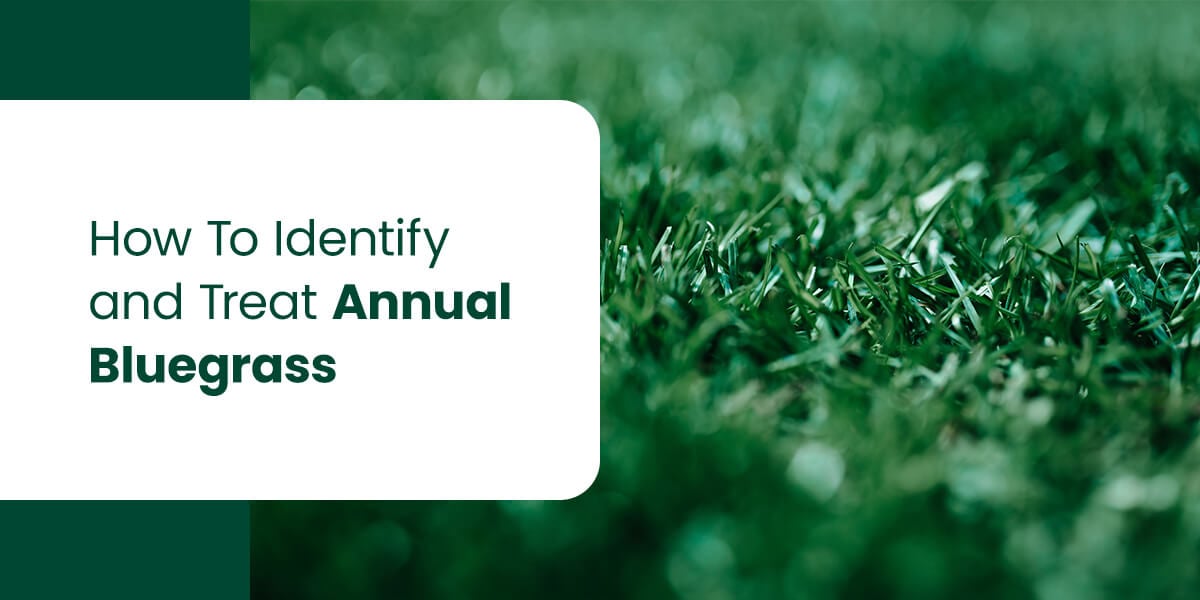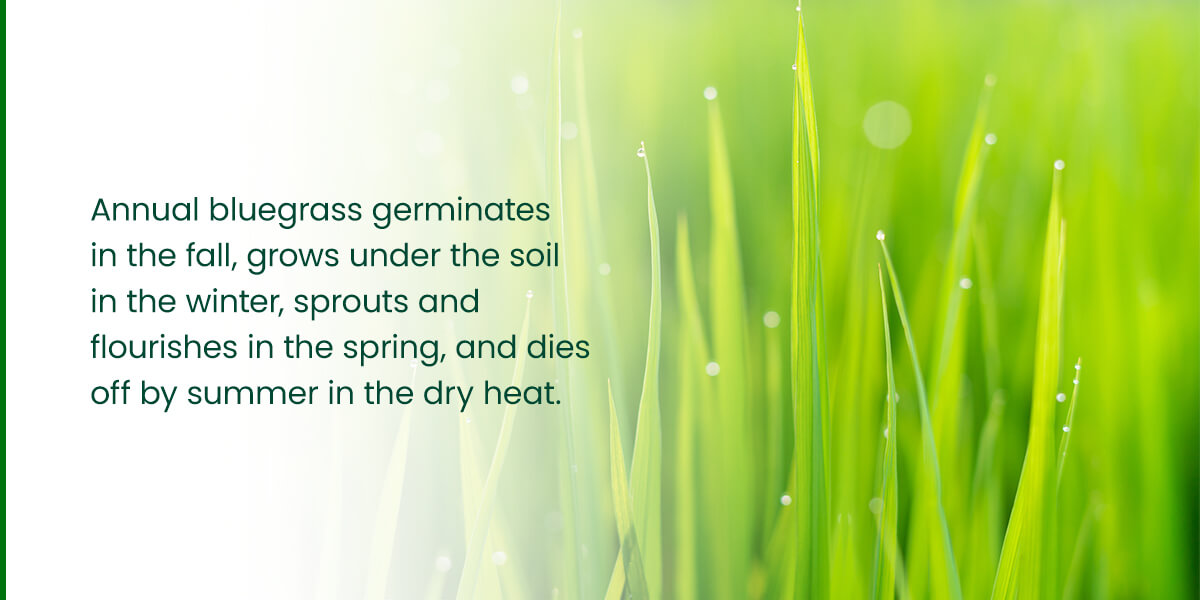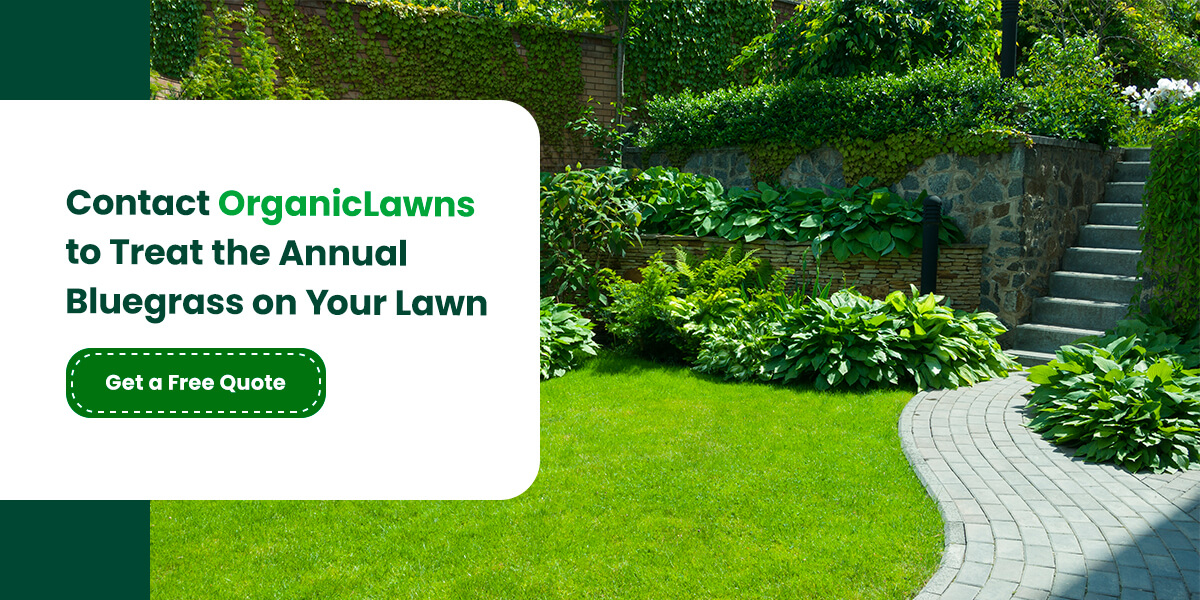
Seasons change, and with this change comes the opportunity for new weeds and sprouts to pop up in yards. For Marylanders, annual bluegrass, also known as poa annual or annual meadow grass, is a pesky weed that finds its way into healthy-looking yards year after year. Its invasive characteristics send many lawn owners looking for a solution to remove it during the spring months. So, how can you spot annual bluegrass in your own yard? And is there any permanent way to get rid of it?
The best ways to treat annual bluegrass are to understand what it looks like, where it pops up, and why it keeps coming back every year. Read on to learn how to identify annual bluegrass, the method to prevent it from spreading, and how to work with lawn care professionals to keep your yard looking fresh all year long.

Typically, annual bluegrass is a short, bright green or yellow weed that has a one-year life cycle. That means it germinates in the fall, grows under the soil in the winter, sprouts and flourishes in the spring, and dies off by summer in the dry heat. The weed is best known for the white buds on the tips of its stems and the way it bunches together — these characteristics make it easy to spot next to healthy grass, which typically grows individually, not together.
Annual bluegrass is native to Europe — the pilgrims transported it to the United States during the 16th century. After the original grass of the Americas burned during an unsuccessful crop season, they brought over the seeds of their grass from England to grow in the colonies. While this benefited their crops, weeds like annual bluegrass found their way to other areas and have become invasive over the years. Although annual bluegrass is found all over the world, it makes Marylanders’ manicured lawns look unhealthy.
Some people may confuse annual bluegrass with Kentucky bluegrass because of their similar names and qualities, but the distinction ends there. Kentucky bluegrass is a popular grass variety that thrives in northern states because of its ability to survive harsh winters and dry summers. Its durability makes it a viable option for Marylanders who want to grow rich green grass in their yard throughout the year. Kentucky bluegrass is a healthy variety of grass to grow in the yard, while annual bluegrass is the type of weed no one wants to see taking over their lawns.
Now that we’ve covered the origin of annual bluegrass, let’s take a look at where specifically it grows in yards. Annual bluegrass is a bunch-type of weed that is especially prone to growing in ground or soil that include the following qualities:
A combination of all these elements can help annual bluegrass spread its seeds across the yard. Once it spreads, the roots stretch inside the soil and the shoots sprout up out of the ground during the spring months. Additionally, this particular weed loves taking over thin turf spaces — like dry patches in the yard — or even spreading over the outer edges of the yard where it meets the sidewalk or driveway. Although annual bluegrass is rarely harmful in a short-term timeline, it is an invasive weed that can cause damage and affect the appearance of yards over time.
Maintaining your own yard may be the most cost-effective but when it comes to pulling weeds, it pays to know what you’re removing from your yard. Without properly identifying the weeds you’re pulling, you could set back your landscaping plans a couple of months. Removing the wrong grass or sprouts could damage the yard, especially because annual bluegrass blends right in with your typical lawn grass.
Identify annual bluegrass in the yard by searching for a green or yellow bunch-type weed with white boat-shaped buds — it’s usually pretty short but spread out wide, like a small bush. Refer to the list above for areas that are prone to annual bluegrass weeds and look there first. Typically, this weed will be found in the problem area of the yard — where the grass meets pavement or places that stay shady or damp. Can you think of any areas that may feature annual bluegrass in your own yard?
Eliminating a weed entirely isn’t an easy task. Annual bluegrass is especially difficult to remove, which is why it’s recommended to actively maintain and prevent the weed from spreading in your yard. Although annual bluegrass is nearly impossible to eradicate, the practical solution is to take cautionary measures in order to manage the growth and avoid any future issues. The following is a list of proactive solutions for preventing annual bluegrass from taking over your lawn. The sooner you start curtailing annual bluegrass, the better. Check out some of the ways you can avoid the weed from taking over your lawn.
Too much of a good thing can turn out to be bad. People may feel the need to water their grass a certain amount of time per week just to keep it looking bright, green and full of life. However, this can invite annual bluegrass to find a home in the damp, cool soil and pop up around a beautifully kept lawn. For similar reasons, the melting snows and rain showers during the spring months, along with cold soil, invites annual bluegrass to sprout in the problem areas of a yard.
Although the seasons and weather are inevitable, you can control the amount you water the lawn. Create a watering schedule and stick to it — whether you use the timer setting on the sprinkler system or water it manually. Examine the lawn’s soil on a regular basis to check on its moisture level. If the soil still feels wet, consider skipping a week to prevent it from becoming too damp — again, annual bluegrass thrives in that type of environment. If your grass looks completely healthy but the soil seems moist and you are still facing issues with annual bluegrass, speak to a professional to get their opinion on how often to water the grass. Moist soil will always encourage annual bluegrass to pop up, particularly in Maryland.
Mowing can be another problem area for people who do their own yard work. Much like overwatering, mowing the lawn too often can create the ideal environment for annual bluegrass growth. Short grass makes it easier for annual bluegrass and other weeds to germinate quickly, whereas tall turf grass shades the soil and prevents weeds from entering the top layer of dirt. For this reason, bald patches and drying sections of grass are prone to more annual bluegrass growth. Cutting the grass too much can cause the seeds to spread rapidly across other areas of the lawn, which helps the germination process as well.
Similarly, mowing over annual bluegrass will only eliminate the blades on top of the soil, not the roots underneath. When it’s time to mow again, you’ll find that the annual bluegrass has popped up again with all new sprouts and white tips. Cutting the tops of this weed does not remove it from the yard. In fact, it may only make it worse. Keep the length of your grass and prevent the germination of unwanted weeds by creating a mowing schedule. Stick to a routine when mowing the lawn to keep it at a reasonable length and avoid cutting it too short and giving the weeds ample room to grow. If a schedule seems like too much responsibility to take on, think about hiring a lawn care professional to handle the lawn mowing for you.
Your grass is only as healthy as the soil underneath, which is why it’s important to care for all aspects of a lawn. Unwanted weeds need to be removed from the root under the top layer of soil, but typically they grow in soil that is already unhealthy, compact, and difficult to dig into. As mentioned above, annual bluegrass likes to grow in tight, compact soil. Its roots will spread underneath the hard surface, making it tough to remove. The most common areas that people find annual bluegrass in their lawn is around the edges — around driveways, sidewalks, or patios. The transition from soil to cement or stone makes the ground harder than other areas of the yard.
Foot traffic is another main reason the soil will compact down. If someone is constantly stepping on the soil, the pressure could be enough to create hard, immovable ground. For this reason, the lawns of newly constructed homes face similar problems. After months of people walking over the property in work boots, it can create a lawn that requires maintenance to bring back to life.
Get down to the root of the problem with the proper lawn care methods, like aeration. In particular, core aeration perforates the top layer of soil for ventilation. The holes leftover will allow nutrients like water and air to sink into the lower layer of the soil and give better access to roots. Creating healthy soil is key to preventing weeds, like annual bluegrass, from finding their way into the tight, problem areas of some yards,
Annual bluegrass is also attracted to ground that is high in nitrogen levels, which is most commonly associated with fertilizers. Chemicals can affect lawns in a variety of ways — some can help the grass and soil maintain a healthy balance, while others create negative reactions that damage the lawn. In particular, nitrogen makes weeds, like annual bluegrass, thrive and take over the yard.
To prevent this from happening, consider changing the type of fertilizer you use. Trade those harsh chemicals found in synthesized fertilizers for more natural, organic ingredients. The switch allows grass to receive the right amount of nutrients they need to thrive through the seasons. It also eliminates any difficult weeds that depend on high chemical levels. For the best results, consult a professional to choose the best organic fertilizer for your lawn.
Chances are if annual bluegrass is in your yard, you may have other invasive weeds as well. The following is a list of common weeds you should look for on your lawn.
Also known as “dead nettle,” “red dead nettle,” or “purple archangel,” purple dead nettle is an invasive annual weed. Its high resilience against insects and plant disease makes it a strong candidate for North American lawns. With a classic square stem and light purple or red tube-like flowers, the purple dead nettle is hard to miss. It can be found in shallow soil around yards, fields, and roadsides.
Much like annual bluegrass, crabgrass thrives in lawns that are over-mowed or areas that have bare turf patches. There are two types of crabgrass that can grow in yards — smooth and hairy — both are equally difficult to remove. Crabgrass’s flat, wide leaf blades grow in tall clusters of flowers and spread quickly. This weed can also bypass mower blades because of its short, clustered leaves. Crabgrass is drought-tolerant, which means it has the ability to grow during the early summer months and last until the ground frosts in the fall.
This weed’s adaptability to seasons and weather conditions helps it germinate easily during the winter and early spring months. Chickweed’s ability to spread quickly makes it difficult to stop — for this reason, prevention is better than eradication. Although it’s possible to remove by hand, using fertilizer and a proper lawn care routine is a better long-term solution. If you’re worried about having chickweed in your lawn, look for broad green leaves with white flowers — resembling something that looks like a small daisy.
Unlike the other weeds mentioned, Bermuda grass can be beneficial in some areas. In particular, the Southern United States uses this long, dark green grass as turf — it’s most common in golf courses, coastal areas, and sports fields. However, in northern states like Maryland, Bermuda grass can take over a yard quickly, leaving areas of a yard brown when it dies in the winter months. This weed looks similar to crabgrass, but with narrower leaves. Maintaining a healthy chemical balance in your yard is key for avoiding Bermuda grass popping up.

Don’t let annual bluegrass stick out like a sore green thumb in your yard. Let OrganicLawns provide the specific mowing, water, fertilizing, and aeration techniques you need for your lawn and help your yard reach its fullest potential. If you’re in the Baltimore area and need lawn assistance, contact us online or call 410.536.5800 to speak to a lawn care specialist and schedule a visit or get a free quote in no time.